Jouer des effets sonores dans Android avec SoundPool
1. SoundPool & AudioManager
Tout d'abord, je propose une situation, vous créez un jeu, il joue les sons tels que les coups de feu, les bombes, ce sont les effets sonores du jeu. Android vous offre une classe SoundPool, c'est comme un bassin et des sons prêts à jouer lorsqu'ils sont demandés.
SoundPool contient un ensemble de source musicale, la source sonore peut provenir du fichier musical dans l'application ou dans le système de fichiers, ... SoundPool permet de lire des sources musicales simultanément.
SourcePool utilise le service MediaPlayer pour émettre des sonores.
SoundPool contient un ensemble de source musicale, la source sonore peut provenir du fichier musical dans l'application ou dans le système de fichiers, ... SoundPool permet de lire des sources musicales simultanément.
SourcePool utilise le service MediaPlayer pour émettre des sonores.

Vous pouvez configurer SoundPool pour créer un son à stream (en type de flux spécifique). Il existe plusieurs types de flux comme suit:
Type de stream | Description |
AudioManager.STREAM_ALARM | Le flux audio pour les alarmes |
AudioManager.STREAM DTMF | Le flux audio pour DTMF |
AudioManager.STREAM_MUSIC | Le flux audio pour la lecture de musique |
AudioManager.STREAM_NOTIFICATION | Le flux audio pour des notifications |
AudioManager.STREAM_RING | Le flux audio quand letéléphone sonne |
AudioManager.STREAM_SYSTEM | Le flux audio pour les sons du système |
AudioManager.STREAM_VOICE_CALL | Le flux audio pour les appels téléphoniques |
AudioManager vous permet de régler le volume sur les différents flux (stream) audio. Par exemple, vous écoutez de la musique sur l'appareil en jouant aux jeux, vous pouvez changer le volume du jeu sans affecter le volume de la chanson.
Une autre chose non mentionnée est que quel périphérique audio produira un son
L'utilisation STREAM_MUSIC, le son sera produit par un périphérique audio (haut-parleur du téléphone, écouteur, haut-parleur bluetooth ou autre chose) connecté au téléphone.
L'utilisation STREAM_RING, le son sera généré par tous les périphériques audio connectés au téléphone. Ce comportement peut être différent pour chaque périphérique.
L'utilisation STREAM_MUSIC, le son sera produit par un périphérique audio (haut-parleur du téléphone, écouteur, haut-parleur bluetooth ou autre chose) connecté au téléphone.
L'utilisation STREAM_RING, le son sera généré par tous les périphériques audio connectés au téléphone. Ce comportement peut être différent pour chaque périphérique.
SoundPool API:
Méthode | Description |
int play(int soundID, float leftVolume, float rightVolume,
int priority, int loop, float rate) | Joue une source sonore et renvoie l'ID du nouveau flux en cours de lecture (StreamID). |
void pause(int streamID) | Pause le flux sonore avec ID est streamID. |
void stop(int streamID) | Arrête le flux sonore avec streamID. |
void setVolume(int streamID, float leftVolume, float rightVolume) | Règle le volume pour le flux sonore avec ID est StreamID |
void setLoop(int streamID, int loop) | Définit le numéro de boucle pour le flux sonore avec ID est streamID. |
2. L'exemple avec SoundPool
Créez un nouveu projet baptisé SoundPoolDemo.
- Name: SoundPoolDemo
- Package name: org.o7planning.soundpooldemo
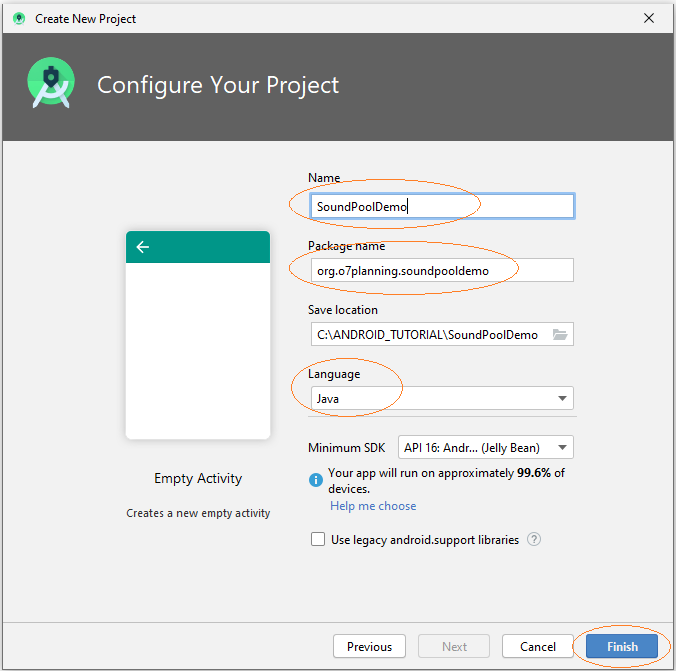
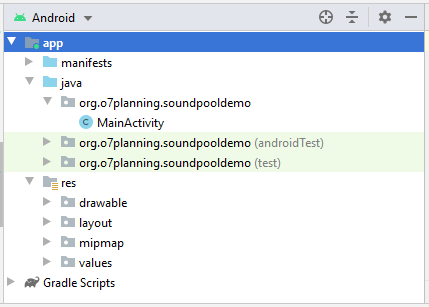
Créez un dossier raw est un sous-dossier de res. Copiez 2 fichiers de musique dans un dossier raw. Ici, je copie deux fichiers sons: l'un qui simule la détruction d'un objet (destroy.wav) et l'autre simule le sonore des coups de feu (gun.wav). Notez que vous pouvez utiliser l'extension de fichier audio mp3 ou wav.
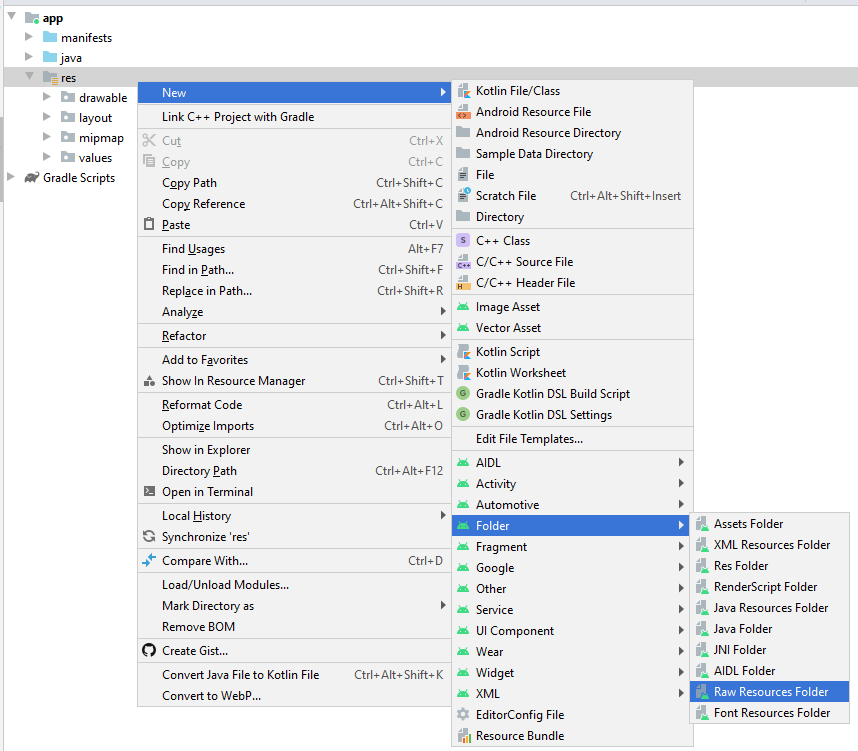
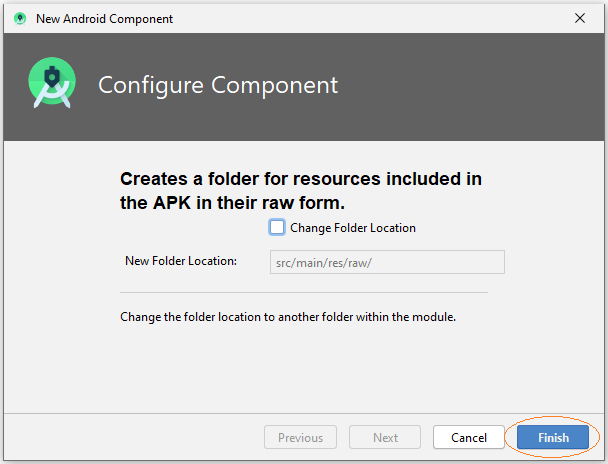

L'interface de l'application Démo.
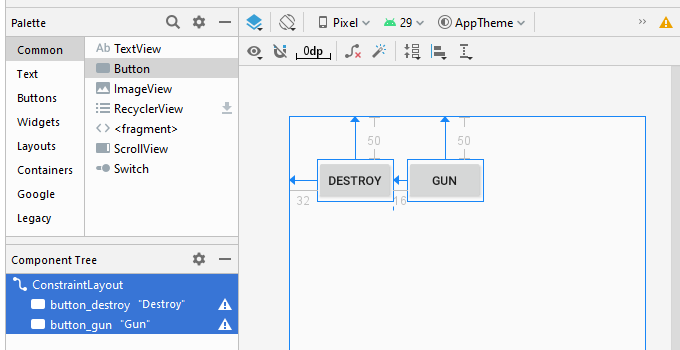
activity_main.xml
<?xml version="1.0" encoding="utf-8"?>
<androidx.constraintlayout.widget.ConstraintLayout
xmlns:android="http://schemas.android.com/apk/res/android"
xmlns:app="http://schemas.android.com/apk/res-auto"
xmlns:tools="http://schemas.android.com/tools"
android:layout_width="match_parent"
android:layout_height="match_parent"
tools:context=".MainActivity">
<Button
android:id="@+id/button_destroy"
android:layout_width="wrap_content"
android:layout_height="wrap_content"
android:layout_marginStart="32dp"
android:layout_marginLeft="32dp"
android:layout_marginTop="50dp"
android:text="Destroy"
app:layout_constraintStart_toStartOf="parent"
app:layout_constraintTop_toTopOf="parent" />
<Button
android:id="@+id/button_gun"
android:layout_width="wrap_content"
android:layout_height="wrap_content"
android:layout_marginStart="16dp"
android:layout_marginLeft="16dp"
android:layout_marginTop="50dp"
android:text="Gun"
app:layout_constraintStart_toEndOf="@+id/button_destroy"
app:layout_constraintTop_toTopOf="parent" />
</androidx.constraintlayout.widget.ConstraintLayout>MainActivity.java
package org.o7planning.soundpooldemo;
import androidx.appcompat.app.AppCompatActivity;
import android.os.Bundle;
import android.media.AudioAttributes;
import android.media.AudioManager;
import android.media.SoundPool;
import android.os.Build;
import android.view.View;
import android.widget.Button;
public class MainActivity extends AppCompatActivity {
private SoundPool soundPool;
private AudioManager audioManager;
private Button buttonDestroy;
private Button buttonGun;
// Maximumn sound stream.
private static final int MAX_STREAMS = 5;
// Stream type.
private static final int streamType = AudioManager.STREAM_MUSIC;
private boolean loaded;
private int soundIdDestroy;
private int soundIdGun;
private float volume;
@Override
protected void onCreate(Bundle savedInstanceState) {
super.onCreate(savedInstanceState);
setContentView(R.layout.activity_main);
this.buttonDestroy = (Button) this.findViewById(R.id.button_destroy);
this.buttonGun = (Button) this.findViewById(R.id.button_gun);
this.buttonDestroy.setOnClickListener(new View.OnClickListener() {
@Override
public void onClick(View v) {
playSoundDestroy();
}
});
this.buttonGun.setOnClickListener(new View.OnClickListener() {
@Override
public void onClick(View v) {
playSoundGun();
}
});
// AudioManager audio settings for adjusting the volume
audioManager = (AudioManager) getSystemService(AUDIO_SERVICE);
// Current volumn Index of particular stream type.
float currentVolumeIndex = (float) audioManager.getStreamVolume(streamType);
// Get the maximum volume index for a particular stream type.
float maxVolumeIndex = (float) audioManager.getStreamMaxVolume(streamType);
// Volumn (0 --> 1)
this.volume = currentVolumeIndex / maxVolumeIndex;
// Suggests an audio stream whose volume should be changed by
// the hardware volume controls.
this.setVolumeControlStream(streamType);
// For Android SDK >= 21
if (Build.VERSION.SDK_INT >= 21 ) {
AudioAttributes audioAttrib = new AudioAttributes.Builder()
.setUsage(AudioAttributes.USAGE_GAME)
.setContentType(AudioAttributes.CONTENT_TYPE_SONIFICATION)
.build();
SoundPool.Builder builder= new SoundPool.Builder();
builder.setAudioAttributes(audioAttrib).setMaxStreams(MAX_STREAMS);
this.soundPool = builder.build();
}
// for Android SDK < 21
else {
// SoundPool(int maxStreams, int streamType, int srcQuality)
this.soundPool = new SoundPool(MAX_STREAMS, AudioManager.STREAM_MUSIC, 0);
}
// When Sound Pool load complete.
this.soundPool.setOnLoadCompleteListener(new SoundPool.OnLoadCompleteListener() {
@Override
public void onLoadComplete(SoundPool soundPool, int sampleId, int status) {
loaded = true;
}
});
// Load sound file (destroy.wav) into SoundPool.
this.soundIdDestroy = this.soundPool.load(this, R.raw.destroy,1);
// Load sound file (gun.wav) into SoundPool.
this.soundIdGun = this.soundPool.load(this, R.raw.gun,1);
}
// When users click on the button "Gun"
public void playSoundGun( ) {
if(loaded) {
float leftVolumn = volume;
float rightVolumn = volume;
// Play sound of gunfire. Returns the ID of the new stream.
int streamId = this.soundPool.play(this.soundIdGun,leftVolumn, rightVolumn, 1, 0, 1f);
}
}
// When users click on the button "Destroy"
public void playSoundDestroy( ) {
if(loaded) {
float leftVolumn = volume;
float rightVolumn = volume;
// Play sound objects destroyed. Returns the ID of the new stream.
int streamId = this.soundPool.play(this.soundIdDestroy,leftVolumn, rightVolumn, 1, 0, 1f);
}
}
}Exécution de l'application:
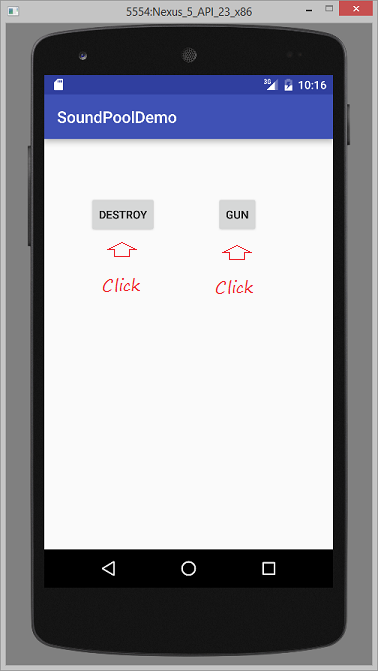
Tutoriels de programmation Android
- Configurer Android Emulator en Android Studio
- Le Tutoriel de Android ToggleButton
- Créer un File Finder Dialog simple dans Android
- Le Tutoriel de Android TimePickerDialog
- Le Tutoriel de Android DatePickerDialog
- De quoi avez-vous besoin pour démarrer avec Android?
- Installer Android Studio sur Windows
- Installer Intel® HAXM pour Android Studio
- Le Tutoriel de Android AsyncTask
- Le Tutoriel de Android AsyncTaskLoader
- Tutoriel Android pour débutant - Exemples de base
- Comment connaître le numéro de téléphone d'Android Emulator et le changer?
- Le Tutoriel de Android TextInputLayout
- Le Tutoriel de Android CardView
- Le Tutoriel de Android ViewPager2
- Obtenir un numéro de téléphone dans Android à l'aide de TelephonyManager
- Le Tutoriel de Android Phone Call
- Le Tutoriel de Android Wifi Scanning
- Le Tutoriel de programmation de jeux Android 2D pour débutant
- Le Tutoriel de Android DialogFragment
- Le Tutoriel de Android CharacterPickerDialog
- Le Tutoriel Android pour débutant - Hello Android
- Utiliser Android Device File Explorer
- Activer USB Debugging sur un appareil Android
- Le Tutoriel de Android UI Layouts
- Le Tutoriel de Android SMS
- Le Tutoriel de Android et SQLite Database
- Le Tutoriel de Google Maps Android API
- Le Tutoriel de texte pour parler dans Android
- Le Tutoriel de Android Space
- Le Tutoriel de Android Toast
- Créer un Android Toast personnalisé
- Le Tutoriel de Android SnackBar
- Le Tutoriel de Android TextView
- Le Tutoriel de Android TextClock
- Le Tutoriel de Android EditText
- Le Tutoriel de Android TextWatcher
- Formater le numéro de carte de crédit avec Android TextWatcher
- Le Tutoriel de Android Clipboard
- Créer un File Chooser simple dans Android
- Le Tutoriel de Android AutoCompleteTextView et MultiAutoCompleteTextView
- Le Tutoriel de Android ImageView
- Le Tutoriel de Android ImageSwitcher
- Le Tutoriel de Android ScrollView et HorizontalScrollView
- Le Tutoriel de Android WebView
- Le Tutoriel de Android SeekBar
- Le Tutoriel de Android Dialog
- Le Tutoriel de Android AlertDialog
- Tutoriel Android RatingBar
- Le Tutoriel de Android ProgressBar
- Le Tutoriel de Android Spinner
- Le Tutoriel de Android Button
- Le Tutoriel de Android Switch
- Le Tutoriel de Android ImageButton
- Le Tutoriel de Android FloatingActionButton
- Le Tutoriel de Android CheckBox
- Le Tutoriel de Android RadioGroup et RadioButton
- Le Tutoriel de Android Chip et ChipGroup
- Utilisation des Image assets et des Icon assets d'Android Studio
- Configuration de la Carte SD pour Android Emulator
- Exemple ChipGroup et Chip Entry
- Comment ajouter des bibliothèques externes à Android Project dans Android Studio?
- Comment désactiver les autorisations déjà accordées à l'application Android?
- Comment supprimer des applications de Android Emulator?
- Le Tutoriel de Android LinearLayout
- Le Tutoriel de Android TableLayout
- Le Tutoriel de Android FrameLayout
- Le Tutoriel de Android QuickContactBadge
- Le Tutoriel de Android StackView
- Le Tutoriel de Android Camera
- Le Tutoriel de Android MediaPlayer
- Le Tutoriel de Android VideoView
- Jouer des effets sonores dans Android avec SoundPool
- Le Tutoriel de Android Networking
- Analyser JSON dans Android
- Le Tutoriel de Android SharedPreferences
- Le Tutorial de stockage interne Android (Internal Storage)
- Le Tutoriel de Android External Storage
- Le Tutoriel de Android Intents
- Exemple d'une Android Intent explicite, appelant une autre Intent
- Exemple de Android Intent implicite, ouvrez une URL, envoyez un email
- Le Tutoriel de Android Service
- Le Tutoriel Android Notifications
- Le Tutoriel de Android DatePicker
- Le Tutoriel de Android TimePicker
- Le Tutoriel de Android Chronometer
- Le Tutoriel de Android OptionMenu
- Le Tutoriel de Android ContextMenu
- Le Tutoriel de Android PopupMenu
- Le Tutoriel de Android Fragment
- Le Tutoriel de Android ListView
- Android ListView avec Checkbox en utilisant ArrayAdapter
- Le Tutoriel de Android GridView
Show More